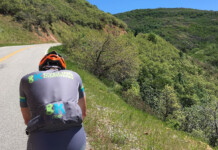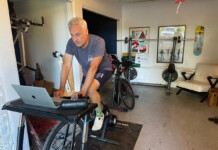November is an exciting month for athletes in Utah. Many are getting back into more structured training following post-summer down time, and those who compete from spring to early fall are already planning and preparing for the coming season of events.
Trail runners, mountain bikers and hikers continue to try to squeeze in quality time and workouts before snow falls – and sticks. Meanwhile, while they wait for the greatest snow on earth, savvy cross-country, tele and downhill skiers, snowboarders and snowshoers are longingly dryland and cross-training.
Both strength and flexibility training this time of year are crucial, yet it is extremely important to enter this phase of the athletic year thoughtfully and carefully. As yoga instructor Anne Gardiner clarifies: “If not properly contextualized within a balanced program, flexibility can result in instability, while strength without flexibility can obviously impede range of motion. Either without the other can limit performance.”
Balance. We all hear this word constantly in the context of virtually every aspect of life, and most of us probably don’t question its importance in everything we do. We can certainly vouch for its validity in scientific training.
Because both strength and flexibility are important ingredients to performance, we emphasize both in the fall months, since they can become neglected when the skiing and riding are good, or when the cycling, triathlon and running seasons are in full swing come spring.
When I first started weightlifting in college, I had the good fortune of having a better informed (and much more “yoked”) buddy who had already become proficient in the form as well as function aspects of “getting ripped”. An informal yet ardent student of bodybuilding as taught by experts of the time, Sven Johannessen emphasized that without proper form, one would not only limit their progress and results, she or he would risk injury.
Strength and conditioning coach, Josh Brockbank, underscores the need to develop an understanding of the subtleties of strength training, since many of the most effective exercises are variations of the same foundational movements. “It’s not that you need to learn or do a ton of different exercises; more than anything you need to know how to perform basal movements with the proper range of motion to complete them safely and most effectively.”
Even before college, as a high school student, I was lucky to have good athletic instructors and coaches who admonished me regarding the dangers of improperly or overeagerly executed flexibility exercises and general stretching – that pushing it could quickly mean pulling it.
Sufficient strength, flexibility and proper biomechanics form the foundation of all healthy and injury-free (or at least injury-avoidant) exercise. Which is why, this time of year, we advise our clients and all inquiring and ambitious minds to seek out experts when expanding their athletic repertoires.
Dave and I have invested heavily in biomechanics training and certification. We (and other competent professionals) can help with optimized bike fit, running stride and cross-country ski technique. For swimming, weight training, Pilates, yoga and other disciplines, we work with some of the region’s best specialists, all of whom take their trades very seriously. They emphasize proper technique for maximal training benefit, results and well being. Several of our clients seek the guidance of these experts, often doing one-on-one sessions in the weight room, pool, yoga mat, Pilates reformer, etc, until they are confident they can perform exercises properly.
As Utahans, we constantly hear the mountains beckon, and when our peaks are blanketed with snow, the din from resorts and backcountry often become irresistible. At the same time, we all know that winter sports carry inherent risks, with pulled muscles and knee injuries commonplace.
Thoughtful physical preparation for all of the above (and other) disciplines can make a huge difference not only in how safely we are able to participate in them, but also the extent to which we enjoy them. Part of that enjoyment can be experienced in the frequency with which we participate – e.g. being able to ski safely and with good stamina multiple days in a row, instead of being sore, fatigued and/or accident prone following an initial outing.
We offer all this in the hope that readers will be motivated to seek expert direction and help as they prepare to either stay fit through the holidays, enjoy seasonal athletic diversions or prepare for a successful competitive campaign. Be smart, be safe and enjoy getting after it!
Mark Deterline and Dave Harward offer over thirty years of combined endurance training and competitive experience. Plan 7 Endurance Coaching provides professional coaching, biomechanics (bike fit, run stride analysis, cross-country ski technique) and performance testing for athletes of all levels. Email them at: [email protected].












